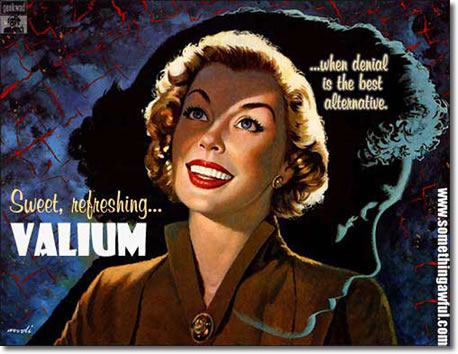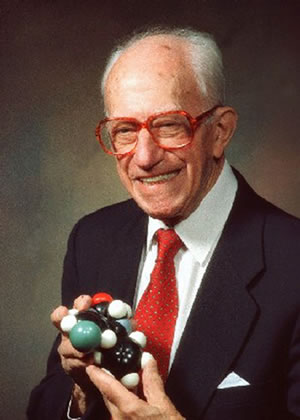Leo Sternbach
Father of Mother’s Little Helper
Even in the 1970s, before the days of the internet, life for many was living in the fast lane. And like everything else, research also moved along at a clipping pace, and very quickly it had devised a drug that attempted to liberate the mind from the stress and anxiety that have become soul mates to the 20th century man.
With the debut of psychoactive drugs, one in particular became celebrated in America as a cure for the sleepless and fear-plagued. To the agitated housewife, it became known as Mother’s little helper, written about in a song by the Rolling Stones:

A not so earnest idea for a valium ad....
It was a lifestyle drug not only for the agitated housewife or the anxious executive, but for all those living in an age when man’s search for meaning and security was being challenged by an ever-changing world. It was a convenient substitute for alcohol - tasteless, odorless and easy to tuck into the pocket. And its popularity grew not only among celebrities, until critics claimed its overuse and new drugs like Prozac, or Zoloft replaced it. The name behind this miracle drug was Valium, a name which grew to be a cultural symbol for the modern world.
Although Valium has long been a household name, few people are familiar with the scientist who developed it - Leo Henryk Sternbach, a research chemist whose origins can be traced back to the picturesque village of Abbazia, located near the Italian border in the former Austro-Hungarian Empire, and in today’s Croatia. Mr. Sternbach died in September at the age of ninety-seven and left a legend worth telling.
Leo H. Sternbach’s father was Polish and his mother Hungarian. As a youth he scavenged gunpowder from unexploded World War I shells and pinched chemicals from his father s pharmacy to make fireworks. After completing a doctoral degree in organic chemistry at the University of Krakow, he went to work for Hofmann-La Roche in Switzerland. He came to the United States in 1941, when all of the company’s Jewish scientists fled Europe at the onset of World War II.

Leo Henryk Sternbach
Sternbach embarked on a spectacular career in chemical research with La Roche Pharmaceuticals in New Jersey. After lengthy experimentation, he developed Diazepam in 1959, dubbed Valium, meaning healthy in Latin. He was given $1 for the drug patent to this pharmaceutical gold mine and $10,000 per year for ten years.
It became all the more obvious how modest this remuneration was, when in 2004 the Wall Street Journal stated that Sternbach’s development of twelve drugs brought in around ten billion USD over four decades.
Profits from his inventions represented 40% of La Roche’s yearly drug sales; most of them were breakthroughs, including the sleeping pills Dalmane and Mogadon, Klonopin for seizures and Arfonad for limiting bleeding during brain surgery Sternbach was primarily motivated by the thirst of discovery, not by acclaim, publicity or financial gain. He wasn’t disturbed that his discoveries didn’t make him a multi-millionaire. What’s important is that you love the work you do, he said. I was successful because I loved my work and was completely dedicated, like any true artist. And being a chemist, I spent most of my life hoping that I could make a difference.
His career in chemical research was distinguished by 241 patents, 122 publications, six monographs and multiple honors. U.S. News & World Report named him one of the most influential Americans of the 20th century. To the pharmaceutical industry, he was the inventor’s inventor.To the man on the street, he was the father of man’s reconciliation with modern age.
Even in the 1970s, before the days of the internet, life for many was living in the fast lane. And like everything else, research also moved along at a clipping pace, and very quickly it had devised a drug that attempted to liberate the mind from the stress and anxiety that have become soul mates to the 20th century man.
With the debut of psychoactive drugs, one in particular became celebrated in America as a cure for the sleepless and fear-plagued. To the agitated housewife, it became known as Mother’s little helper, written about in a song by the Rolling Stones:
Kids are different today/I hear every Mother say/Mother needs something to calm her down/And though she’s not really ill/There’s a little yellow pill/She goes running for the shelter/of a mother’s little helper/and it helps her on her way/gets her through her busy day.

A not so earnest idea for a valium ad....
It was a lifestyle drug not only for the agitated housewife or the anxious executive, but for all those living in an age when man’s search for meaning and security was being challenged by an ever-changing world. It was a convenient substitute for alcohol - tasteless, odorless and easy to tuck into the pocket. And its popularity grew not only among celebrities, until critics claimed its overuse and new drugs like Prozac, or Zoloft replaced it. The name behind this miracle drug was Valium, a name which grew to be a cultural symbol for the modern world.
Although Valium has long been a household name, few people are familiar with the scientist who developed it - Leo Henryk Sternbach, a research chemist whose origins can be traced back to the picturesque village of Abbazia, located near the Italian border in the former Austro-Hungarian Empire, and in today’s Croatia. Mr. Sternbach died in September at the age of ninety-seven and left a legend worth telling.
Leo H. Sternbach’s father was Polish and his mother Hungarian. As a youth he scavenged gunpowder from unexploded World War I shells and pinched chemicals from his father s pharmacy to make fireworks. After completing a doctoral degree in organic chemistry at the University of Krakow, he went to work for Hofmann-La Roche in Switzerland. He came to the United States in 1941, when all of the company’s Jewish scientists fled Europe at the onset of World War II.

Leo Henryk Sternbach
Sternbach embarked on a spectacular career in chemical research with La Roche Pharmaceuticals in New Jersey. After lengthy experimentation, he developed Diazepam in 1959, dubbed Valium, meaning healthy in Latin. He was given $1 for the drug patent to this pharmaceutical gold mine and $10,000 per year for ten years.
It became all the more obvious how modest this remuneration was, when in 2004 the Wall Street Journal stated that Sternbach’s development of twelve drugs brought in around ten billion USD over four decades.
Profits from his inventions represented 40% of La Roche’s yearly drug sales; most of them were breakthroughs, including the sleeping pills Dalmane and Mogadon, Klonopin for seizures and Arfonad for limiting bleeding during brain surgery Sternbach was primarily motivated by the thirst of discovery, not by acclaim, publicity or financial gain. He wasn’t disturbed that his discoveries didn’t make him a multi-millionaire. What’s important is that you love the work you do, he said. I was successful because I loved my work and was completely dedicated, like any true artist. And being a chemist, I spent most of my life hoping that I could make a difference.
His career in chemical research was distinguished by 241 patents, 122 publications, six monographs and multiple honors. U.S. News & World Report named him one of the most influential Americans of the 20th century. To the pharmaceutical industry, he was the inventor’s inventor.To the man on the street, he was the father of man’s reconciliation with modern age.
